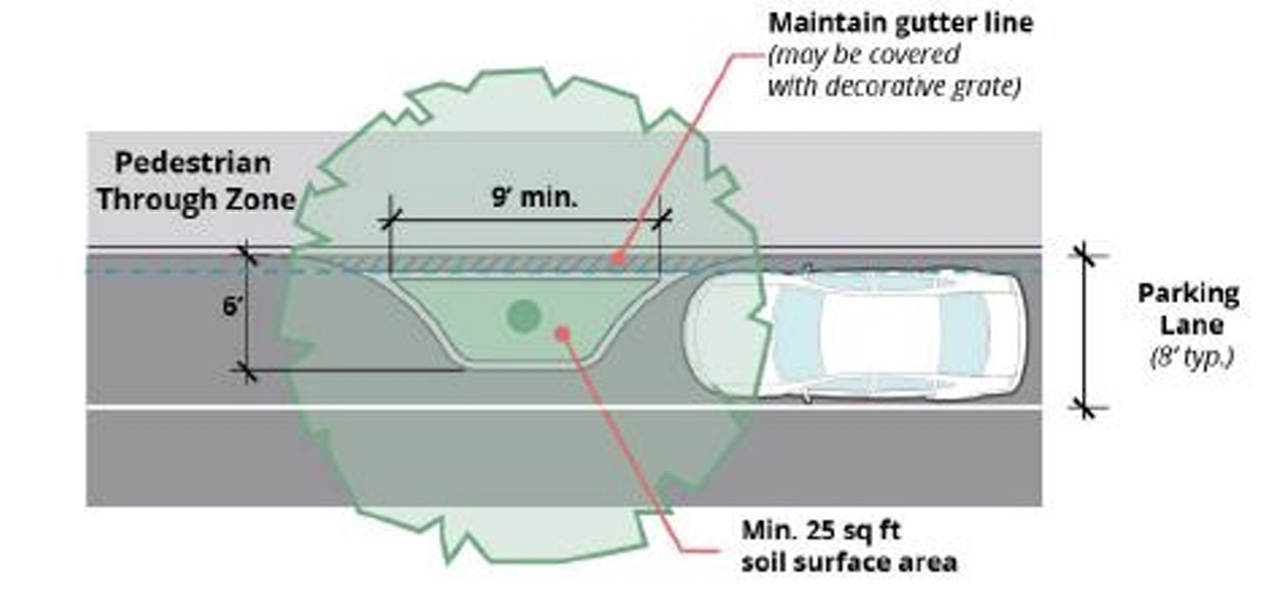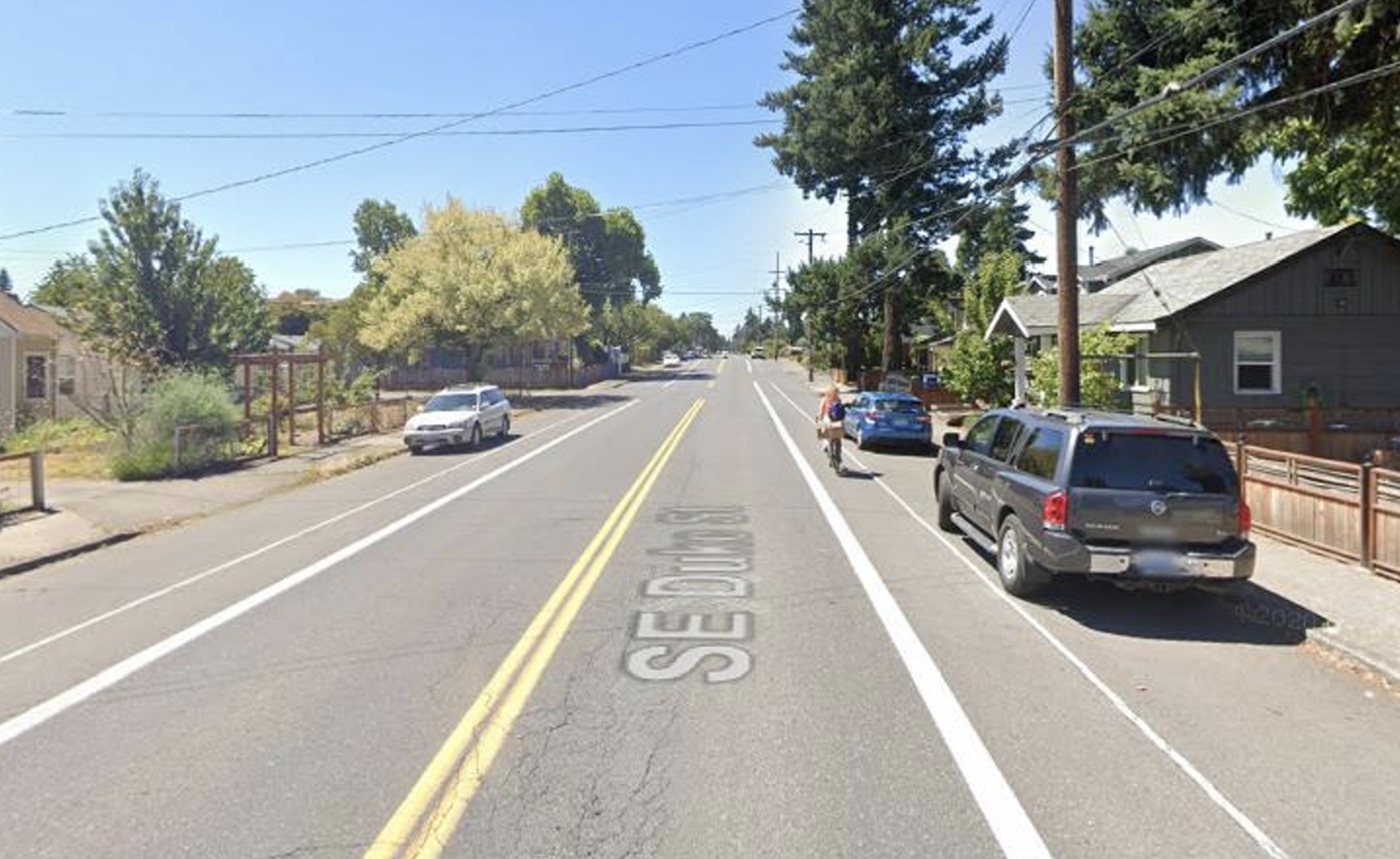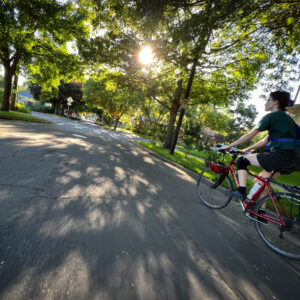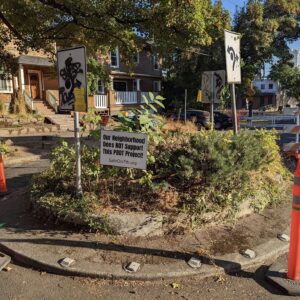“If you don’t do something like this, these trees aren’t happening.”
-Gena Gastaldi, PBOT
Good news for Joni Mitchell and fans of sustainable city planning in Portland: the Portland Bureau of Transportation is considering depaving paradise and trading parking spaces for trees.
Though many neighborhoods in Portland’s central city are as green as can be, this isn’t the case everywhere. Tree canopy coverage is unevenly distributed across the city, with people in wealthier parts of Portland benefitting the most from dense urban forestry that lower-income neighborhoods are largely devoid of. As climate change continues making our summers hotter and the cooling effect of urban forests becomes even more palpable, the disparity between the tree haves and have-nots will be more apparent. Climate justice advocates have called on the city to make sure all Portlanders have access to trees, and planners have begun to include more greenery in their blueprints for new street designs, especially in lower-income parts of the city where concrete is king (like 122nd Ave).
At yesterday evening’s Portland Pedestrian Advisory Committee (PAC) meeting, PBOT’s Interim Pedestrian Coordinator Gena Gastaldi gave a rundown of a new city street tree pilot project.


This pilot plan, a collaboration between PBOT, Portland Parks & Recreation’s Urban Forestry team and the Bureau of Environmental Services, aims to “develop a framework for tree planting in the curb zone.” It will be funded through a $500,000 grant awarded to PBOT by the Bureau of Environmental Service’s Percent for Green program, which uses a percentage of development charges to fund green infrastructure projects that “provide broad benefits for watershed health and the community.” The pilot is part of the recently-updated Pedestrian Design Guide, which has a large section dedicated to improving tree canopy coverage on Portland’s streets.
But beefing up canopy coverage is more complicated than just taking a shovel to the dirt. Particularly in the most car-dominant parts of the city (which are also often the poorest), sidewalks are narrow and there often isn’t enough room for trees. To confront this challenge, PBOT’s pilot would take tree planting beyond the limited sidewalk furnishing zone and into spaces previously reserved for cars.
PBOT has recently faced backlash from people threatened by their plans to reallocate on-street parking, notably on NW Overton, where the agency ended up scrapping an already-built bikeway to reinstall parking spots. It’s apparent they’re wary of this happening again and want to get ahead of any controversy: documents outlining this plan clarify that turning some parking spaces into habitats for trees is essentially a last resort for fitting greenery into tight spots, and Gastaldi said PBOT will practice restraint with on-street parking conversion.
“We’re not talking about getting rid of all the parking. We’re talking about strategically reallocating some of that space,” Gastaldi said at yesterday’s PAC meeting. “If you don’t do something like this, these trees aren’t happening.”


You can see examples of these curb extension planting zones in several places around Portland, such as near Director Park downtown and on SE Hawthorne near 46th Ave. But these were created as one-off projects with no intent to replicate them elsewhere. Now, PBOT and BES are going bigger with their plan.
In addition to the benefits trees provide for on-street cooling (and more), one important point PBOT makes is that street trees have proven valuable as a traffic calming enhancement. This is true: studies have shown the presence of trees improves traffic safety by encouraging drivers to slow down – similar to the calming effects of on-street artwork, but with more photosynthesis – and this effect can be amplified by planting them outside of the sidewalk and in the street itself. (This is one reason people were so angry about PBOT removing the tree from the traffic circle at SE 7th and Tillamook.)
Right now, planners are still determining where to first focus their tree-planting efforts, but it will likely first take off somewhere in the greenery-starved neighborhoods in outer southeast. They may tie this pilot into the Lower SE Rising Area Plan in the Brentwood Darlington neighborhood, utilizing the community engagement efforts already underway for that plan to also get public input on the street trees project.
The planning and engagement process will take place through the rest of this year and next year, with construction starting in 2024. You can find out more about the plan here – we’ll keep you posted on more details when they’re available.








Thanks for reading.
BikePortland has served this community with independent community journalism since 2005. We rely on subscriptions from readers like you to survive. Your financial support is vital in keeping this valuable resource alive and well.
Please subscribe today to strengthen and expand our work.
It’s just so frustrating that PBOT can’t even begin to dream bigger on anything. Every road re-design that allows for free street parking over space for trees, cyclists, or wider sidewalks is an absolute failure. If the city is serious about reducing VMT, then it needs to be serious about taking steps which actually, you know, reduce vehicles miles traveled. Removing parking is definitely one of those steps.
And the fact that they call that stretch of SE Holgate “a tight spot” is really wacky. It’s got an 11 foot center turn lane! If they got rid of that, widened the sidewalk by a few feet and used the rest of the space for trees they wouldn’t need to do any of this “desperation” stuff. Inner Division makes do with about 16 total feet for a travel lane and parking, why does outer Holgate need 18? There’s a few more feet.
I just see projects like this and scratch my head – everyone recognizes the issue for the roads in outer east Portland (too wide, with fast traffic, not enough tree cover, and horrible walking conditions), but the means to solve that is never narrow the road/reduce the space for cars.
Moving the curb even a few inches let alone 4 to 8 feet requires moving the sewers, water lines, and a bunch of other utilities, which then makes the whole project cost-prohibitive. Instead, this project keeps the current curbs intact but creates curb-extensions for trees and shrubbery, making it much cheaper.
Holgate actually had quite a road diet in 2009, so we can’t say they never reduce space for cars. Prior to the diet there was no designated bicycle facility at all.
https://www.portlandoregon.gov/transportation/article/295402
The road still kind of sucks, but it’s trended in the right direction.
Center turn lanes enable fewer through lanes by removing turning vehicles from those lanes, which is also safer. The center space can also be used for one of the most effective safety tools for pedestrian and cyclist crossings – median islands.
SE Division is 36 feet wide west of 60th. That’s the standard 10 ft travel lane and 8 foot parking lane for each direction of travel.
Your comments indicate an unfamiliarity with all PBOT has done and is currently working on in east Portland.
https://www.portland.gov/transportation/pbot-projects/construction/east-portland-arterial-streets-strategy-epass
Stretches like the Holgate example above seem ripe for median large form street trees as opposed to parking strip street trees. As noted by blumdrew, there’s loads of space. Additionally, we know access management–ie fewer curb cuts and left turn opportunities–also slows people and reduces conflict. Let’s advocate for PBOT to add a “Large form street trees in the median” program!
Median barriers are a proven safety countermeasure, but also costly. Median islands help pedestrians cross, but islands are more prone to being struck by errant drivers than full length medians are, not to mention trees that only get bigger over time.
Your ‘access management’ is also someone else’s ‘inconvenience’ and ‘destroying businesses’.
Sewers are often at the center of streets, so that’s an issue regarding tree roots.
Then there is emergency access.
All these trade-offs (and more) factor into how to redesign streets.
This looks great. I hope it can expand throughout the city. It makes so much sense–it keeps sidewalks unobstructed, gets trees away from buildings, puts more tree canopy over street pavement, allows wider trees, allows decently-sized planting areas instead of constrictive grates, gets trees out somewhat from under overhead wires…
Any block with on-street parking can have a continuous row of large street trees at the cost of a couple parking spaces. It has huge potential for adding to urban tree coverage.
What about bike lanes? Doesn’t this preclude them from being added in the future?
Of course it does. That’s why bump outs for pedestrians needs to be evaluated further. What’s funny is I literally spoke to a PBOT staffer recently who said they are not looking into more items that they can maintain due to the backlog that they have. This is all confusing. It almost seems like the city doesn’t know what they are doing within house. I’m continually losing faith that these folks can handle this task.
Yes, in many cases the trees would be right where a bike lane might go.. On the other hand, adding bike lanes can preclude adding trees. One might be the best design in one area, the other in another area. There might also be locations where both would work (trees replacing some parking spaces, and a bike lane created by removing a vehicle lane, for instance).
Since the street trees are meant to be in the parking lane, the bike lane becomes a non-issue. If the bike lane is in the door zone next to traffic, then the trees and parked cars are to the right of the bike lane; similarly if the bike lane is next to the curb, then the trees and car parking is in the buffer zone next to car traffic.
I think it would depend on the configuration. On 122 ave, there’s parking at the curb, and bike lanes between the parking zone and the motor vehicle lanes. This kind of thing would work great there and not impact the existing bike lanes. It could preclude parking protected bike lanes (which I personally hate), I suppose.
I’m a broken record at this point but why weren’t trees and bioswales part of the recent work on SE Division between 92nd and Gresham? What a pathetic waste of an opportunity. On top of the lost opportunity maybe it would have slowed the lifted trucks from just driving over the dividers. It just turned this area into much more of a Mad Max scenario. You want to talk about setting fire to tax payer money. What kills me is the did do a couple trees between 82nd and 92nd. Just say you hate us.
It’s my understanding that despite the initial concepts showing lots of trees on Division, they ultimately had to eliminate a majority of the plantings due to sewer and water lines. I’m all for brodozer-eating bioswales though.
There was a plan for trees in the center median the whole stretch of Division, but a large water transmission line precluded almost all of them. I believe the idea of a center swale was dismeissed because the road is center crowned and reversing the grade along the entire road and at every cross street was not feasible. Even if they had reveresed teh grades, I think the water/sewer infrastructure is too close tothe center to have stormwater treatment facilities above them (aturated soils can allow the pipes to settle and break). Some ideas that I don’t think were considered: underground the power and/or consolidate the power to one side of the road and widen the planters on the south side of Division- which means narrowing the planter on the north side and a very expensive curb shift along the entire street!
I don’t want to dismiss your frustration, but PBOT was actually convinced to plant trees on the Outer Division project and spent considerable effor to do so, but there were some very real constraints, unfortunately.
Green curb extensions and swales are not one-offs, but part of the standard to reduce storm water infiltration where sewers and storm drains are combined.
There has been a narrow version of this on NE Davis between 7th and 8th for many years. https://goo.gl/maps/LKBf68zxgknKhpCd9
The Overton comparison is off as well. The density in the Pearl is some of the highest in Portland. East of 82nd Avenue, not so much. Parking demand is related to density.
I’m surprised to not see more pushback on this from the bicycle advocate community. Doesn’t this basically lock in the parking lane and preclude curb-side protected bike lanes in the future? What about the bike bill lawsuit, wouldn’t that say these trees should be torn out if the street is ever reconstructed? I’m seeing a lot of contradictions here.
maybe it’s possible to move the trees a little farther in to the road and then have the bike lane between the trees/parking and the sidewalk? Seems like it would fit but I’m no arborist
As long as there are no utilities directly underground, and the tree has enough room to grow, it should be fine.
Indeed, protected bike lanes are PBOT’s preferred design where mode separation is called for. They should really be putting the trees (and parking) where the bike lane is now, with the bike lane shifted next to the curb. To do otherwise seems oddly self-defeating.
Some strange happenings in the PBOT think tank. Trees along the already rich in canopy SE Hawthorne area? Wild. I have a feeling taking parking away from folks in the already under appreciated and under resourced BD hood will not sit well. The roads are terrible. There’s places where one would have to walk 1/2 mile to the closest bus line. City planners like Scott Cohen continually give band aid fixes, which I could rattle off. But, lack of safe crosswalks, sidewalks, and any reasonable “up to code” upgrades aren’t coming. But wildly placed trees and silly alternative walkways on are subpar streets are. People struggle to use their wheelchairs and motorized scooters on the neighborhood streets. No wonder why people are voting differently. People need basic infrastructure. City hall is so far removed from BD. Meanwhile, a simple ride along the new and improved areas of SE Linwood in Milwaukie just makes it worse. BD needs a Clackamas county rescue plan.
I agree that this doesn’t make much sense on SE Hawthorne, but I live in East Portland, and this would make a big, big difference to the streets out here. For instance, the planned 122 ave improvements include adding more trees as well along with widening sidewalks, adding new and improving existing pedestrian crossings, and adding buffers to the bike lanes. That said, I understand the concerns out here in EP are different than in BD and agree city hall definitely needs to do more work understanding the different needs of different parts of Portland and making sure the basics are in place across the board before planning vanity projects.
Although I find it wild that people want trees within the median (because people cross wherever they’d like out east, which makes visibility and issue) I can see that being an idea. But I most certainly don’t want any potential bikes infrastructure to be erased or missed because of it. We need trees in yards. We need trees in parks. I lived off of 182nd. I worked off of 174th for years. There’s plenty of open areas for trees.
New zoning rules disincentivize yard trees in many areas by shrinking or eliminating yards.
The trees on Hawthorne were planted by BES, not PBOT.
We can agree that they all have their collective hands in the jar. They may not chat about all projects but I’m sure PBOT was either notified or was able to comment on it
Yawn, nothing to see here, just a bit more ‘experimental’ BS from the fairly unimaginative minds at PBOT.
You are not going to get rid of cars, you will just get rid of the customers for businesses in areas without parking. People need to be real about who not owning a car means in this city. People over 40 aren’t going to schlep to the grocery, out to dinner or go shopping via a bus. Younger people aren’t going to leave work early stop make it to school in time to pick up their kids via a bus. Buses are great for getting to work, but otherwise, it is ridiculous to think that people can live their lives dependent on public transportation. It is laughable. The continued war on cars is not hurting anyone but the city. The parking-less apartments have just made neighborhoods in to parking lots. The removal of parking downtown has helped destroy our once vibrant city. I don’t know one person in my neighborhood or workplace that rides a bus anywhere other than to work.
There are countless examples worldwide of cities and countries that don’t have nearly our car dependency levels. They’re able to get their groceries and go out to eat just fine. Part of that of course requires better people oriented (i.e. not car focused) design so people can walk to more places as well.
Heck even look at NYC in this very country. their car ownership rate is very low compared to us. Obviously their public transit is better than ours and we need to catch up, but that’s no reason to assume that Portland has to cater solely to cars forever. We can and will progress.
People often cite Germany or France as examples of this, and it’s true in many of the core urban areas that Americans tend to see when they travel people don’t use cars to do their daily business. (It’s also true in parts of Portland.) But at the same time, outside of the urban cores all across Europe, there’s a lot of driving going on, just like America.
It may be different, but it’s not so different.
What does this tree solution have to do with getting rid of cars? It’s literally a way to add street trees while allowing on-street parking.
The amount of parking taken away is minimal. The tree area is 9′ long at the curb. Take away about 2′ from each side (since car bodies overhang wheels by about that, and that leaves only about 5′ of lost curb length. Parallel parking spaces need almost that much between ends of cars to be able to get in and out, meaning the practical loss of curb length is only a couple feet per tree at most.
So using this solution, you could create a near-continuous tree canopy along a block while losing only about one space per block. Very roughly, a 200′ long block with no driveways has about 8 parallel spaces (at about 25′ length/space). So you can transform a treeless street into a beautiful tree-lined one while keeping nearly 90% of the on-street parking.
lol imagine thinking what made Portland vibrant was the parking lots
I would love to replace the parking lane in front of my house with trees.
Just one more obstruction in the curb lane when it comes to deciding on bike infrastructure or not. I am generally not a fan of gutter bike lanes; but, these trees, like the curb extensions before them, preserve and memorialize the curb lane for motor vehicle parking. So as far as climate goals go, IMO this is pretty much a wash or a loss and not a gain.
The current design pattern with curb bulbouts is also solidifying the parking areas.
Yeah I said that.
“…these trees, like the curb extensions before them…”
I agree, trees can be planted anywhere. Bike lanes and infrastructure is precious. The wonks are getting this wrong.